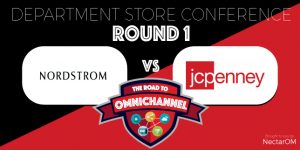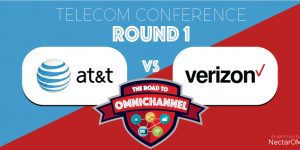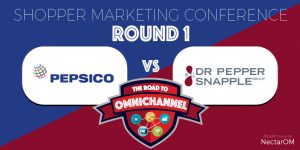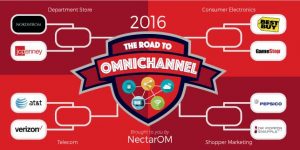The next Round of The Road to Omni Channel Tournament ended with two “old-school” retail brands, Nordstrom and JCPenney. One brand, arguably the best customer service in the industry, and the other, a story of perseverance and come back. At the end of a tough game, Nordstrom’s unwavering strategy was upset, 71-68, by scrappy JCPenney’s frenetic pace of play and a half court heave.
The Play-By-Play
There aren’t too many business sectors experiencing the kind of pressure big box department stores face today. Foot traffic continues to decrease and in-store sales are stagnant. Meanwhile, online sales are increasing more than 30% over the next couple of years so companies like JCPenney and Nordstrom have no choice but to make omni channel a top priority. Each has done it differently, but both have made amazing strides, recruited deep teams and get solid play from every channel.
Nordstrom’s game was about everyone buying into a philosophical approach from the tip. Their relentless focus on customer service resulted in an unbreakable zone defense which covered the competition like a blanket. JCPenney never had an uncontested shot whether it was in the store, on desktop, mobile web, their app, social channels or from the customer service line.
Just when you thought there couldn’t be a deeper bench, JCPenney showed up with matchups for each channel, but also included a strong SMS player. That said, the difference in style was palatable. JCPenney played a full-court defense that poked at you like a jackhammer to concrete. There was a dizzying number of deals, discounts, clubs, groups, communities, opt-ins, points and promotions on every square inch of the court.
The offenses were opposites, as well. Nordstrom ran a smooth motion offense that was like watching a jazz ensemble in perfect sync. Crisp passes from desktop web into a login experience, to the mobile web, to the app, to push messaging and a perfect feed for a slam dunk from email was commonplace. The abandoned cart emails, location-based recommendations, and previous product views were all points of personalization and they occurred in nearly every channel. As a result, they posting the highest shooting percentage of any team in the tournament.
JCPenney played every offensive set like it was the end of the game tossing up three pointers from everywhere on the court. You could hear Desktop Web screaming every second of the game, “5 off 25! Buy one get one! Free, free, free!” Their shooting percentage wasn’t great, but the points stacked up as scoring runs that would rattle any team…except Nordstrom.
The summary of the game is best described as “streaks vs steady” with one streak too many. At the end of the game, JCPenney came back from a ten-point deficit with :46 left and their SMS player put the last nail in the coffin with a text from just beyond half court giving them a three-point win.
Key Stats – The Hammer vs The Diamond
When you compare these two teams the styles couldn’t be more different, but the stats were almost mirror images…
- Cross Channel Experiences – Both teams drove to store via directions, allowed you to add events to calendars, barcode scanning in app, and localized content. Nordstrom did edge out JCPenney by highlighting and connecting you to their many events they offer in store across the country.
- Operations – Every shot from the charity stripe went in for both teams, because they followed each purchase, opt-in and question with appropriate messaging. Nordstrom got extra points for their copy tone. Instead of standard requests for location or opt-in, they repeatedly presented benefits to giving them access and used cheeky copy throughout. They also won in store, because of the autonomy they give their staff and their very cool pop-up stores.
- Recognition – Both companies will serve you well if you log-in, but it appears they’re both targeting anonymously, as well, at times.
- Consumer Journey – Both teams were lacking a little in this area, but JCPenney dominated Nordstrom by integrating their Wedding and Baby registries online and in the app.
- Recommendations – These were served up in a fairly typical fashion using widgets to introduce what others like you looked at or bought. Both parties could elevate recommendations to better match their brand essence: Nordstrom, by auto-emailing recommendations via local sales associates like they currently send manually; JCPenney, by personalizing their offers and discounts. Prior to the Ron Johnson era JCPenney shoppers used to love gaming the system with the mass of coupons floating around so why not embrace that gamification?
Conclusion
It’s clear JCPenney’s had challenges withstanding a rotating door of leadership at the institution and coaching ranks, but they appear to have rallied around omni channel. They’ve returned to their roots as an “in your face” couponer and elevated their game in store, but they still have to deal with the squeeze from competitors at both the top and the bottom. The jury is out, but they live to play another game.
Nordstrom is the classic Duke Blue Devil doppelganger. They play their game first, you know they’re always going to be in the mix and they’re extremely well coached. The players are given great autonomy so they have success from the floor of the store to the online customer service. It didn’t work out this time, but count on seeing them next year.








